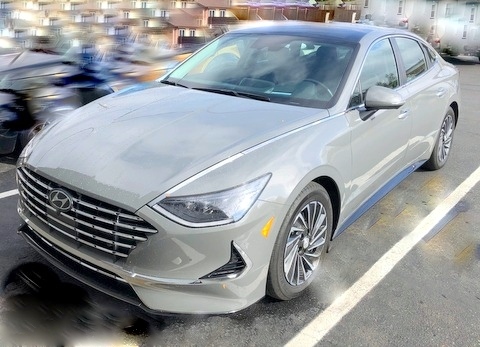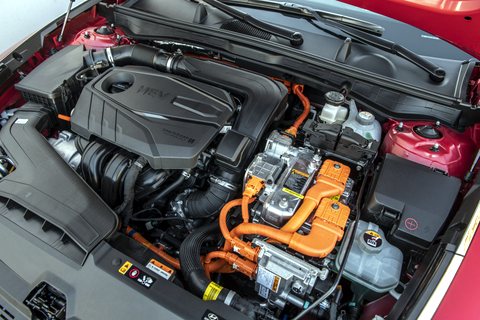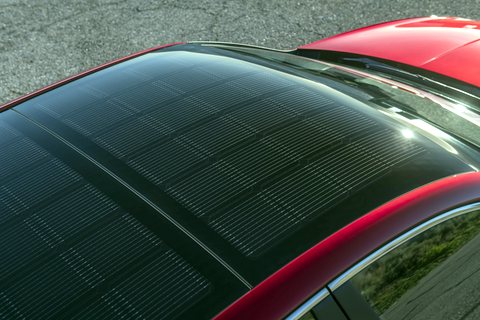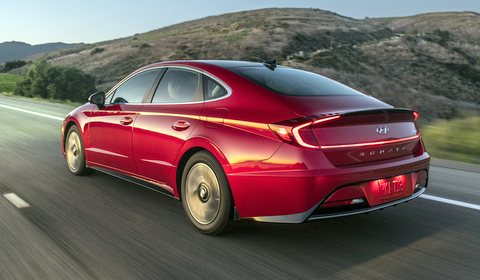All New and Quite Efficient
In a world dominated by crossover SUVs in all sizes and price levels, there is still a market for good old-fashioned four-door sedans. If you want one, the eighth-generation 2020 Hyundai Sonata is quite a looker. It offers an alternative to the ubiquitous Toyota Camry and Honda Accord sedans, and with its hybrid drivetrain, averages up to 52 miles per gallon.

Years ago, Hyundai’s products were for the most part derivative and unexciting, but that changed a couple of generations back. Hyundai likes to name its style themes, and this one, for the exterior design, receives the compelling moniker of “Sensuous Sportiness.” That means that the sedan has bold, flowing lines and proportions and boasts a coupelike roofline. It even sits an inch lower than the previous generation. It was teased originally at the 2018 Geneva Auto Show as the Le Fil concept.
The new “Digital Pulse Cascading Grille” dominates the front end and looks nothing like the face of the seventh-generation car. Actually, it doesn’t resemble anything else on the road. The Sensuous Sportiness theme debuts here, but is now popping up on the latest compact Hyundai Elantra, too. The rest of the car flows smoothly from nose to tail, avoiding the oddball aggressive shapes now finding their way onto more and more new vehicles.
Hyundai has figured out how to hide lighting in chrome, so the strip along the headlamps actually contains the daytime running lights!
Smooth and Quiet
A smooth car pushes less air out of its way, and the gasoline-only Sonata has a very good 0.27 coefficient of drag (Cd). The gas-electric Hybrid improves that to 0.24. Remember, every bit of reduction in the Cd adds to fuel economy! Airflow-enhancing updates on the Hybrid include a bumper lip, front- and rear-wheel deflectors and undercovers below the car.

The car’s also quiet, with numerous noise-reducing techniques, including sound-absorbing glass and increased insulation. When you’re driving using only the electric motor, you feel like you’re floating down the road.
The 2020 Hyundai Sonata Hybrid uses a 2.0-liter gasoline direct-injection four-cylinder engine mated to a 39-kilowatt electric motor powered by a 270-volt lithium-ion polymer battery pack. The system horsepower totals 192, with the odd math of combining 150 horsepower from the engine and 51 from the motor. You can watch it all in action on the 10.25-inch center screen or in an abbreviated version on the instrument panel.
Engine and motor power run through a six-speed automatic transmission with active shift control technology. This sophisticated system monitors shifts 500 times per second to reduce shift time and smooth the shifts themselves. That means better acceleration and improved fuel economy.
Fuel economy numbers are comparable with the Toyota Camry and Honda Accord Hybrids. My tester, a top-of-the line Limited model, was awarded ratings of 45 mpg city/51 highway/47 combined by the U.S. EPA. The entry-level (but well-equipped) Blue model rates a better 50 city/54 highway/52 combined. The higher numbers are likely due to lower weight from packing fewer extra features. I averaged 38.6 mpg—below the official numbers, but it was over a short test.
Somber But Likeable
My tester, in a somber Hampton Gray with black interior, was easy to like, if not love. The style is pleasant in the parking lot or in your driveway, and the driving experience is great for a sedan. There’s enough power to boost confidence, but not enough to get into trouble. When driving with only the electric motor running, it’s bliss.

The Sonata has always offered top-ranked interior room, and the leather seats in my tester were comfortable for the few trips I made in these pandemic times. Hyundai has dubbed its new “spread wings” interior design “Beautifully Smart.” As has been the norm in Hyundais for at least the last decade, materials are of high quality and precisely assembled, and the switchgear is sturdy and satisfying to operate. Hyundai has made a deal with Bose, and the 12-speaker sound system with subwoofer is sublime.
This modern vehicle offers various types of electronic driver support, including forward collision avoidance assist, lane keeping assist, and adaptive cruise control—all standard. You can opt for highway driving assist, which helps with lane centering and maintaining appropriate speed and distance, reducing driver fatigue. There’s plenty of lifesaving tech, too, from airbags to crush zones, to keep you alive if all the other tech can’t help you avoid a crash.

I was excited about the solar panel roof. With its size, it isn’t powering the car a whole lot, but Hyundai says you pick up a couple of miles of range a day from it—or about 700 miles a year. With the advance of technology, who knows—maybe someday solar roofs will power the car on their own. You can monitor the roof panel charging in the center panel display!
Also exciting is the rearview camera that appears in either of the two gauge circles on the configurable instrument panel—right when turning right and left when turning left. I used the Qi charging pad in the console to add electrons to my phone as I drove.
The Bottom Line
Pricing for the 2020 Hyundai Sonata Hybrid is, by today’s standards, quite reasonable. The Blue model starts at just $27,750, the midline SEL begins at $29,900, and the Limited base prices at $35,300. Add $975 for shipping to each price. There are numerous extras to distinguish each level—consult the website for more information. My tester, with everything included except carpeted floor mats ($155), came to $36,430.

This car is a hybrid—not a full electric or plug-in model, so why am I testing it? While the move to electrified transportation is inevitable, there is still a case for driving a regular hybrid that doesn’t plug in but gets 50 miles per gallon, if you are not set up for home charging. Owners of all-electric cars without home charging may be willing to rely on public charging stations, but part of the charm of a plug-in hybrid is that you can use regular, low-voltage household current to top off your car’s relatively small battery pack overnight and then do all your local driving gas-free. Then, when you take an occasional long trip, it’s range-anxiety-free. No expensive equipment or inconvenience required! That being said, with a good hybrid vehicle, you are doubling your fuel economy, essentially taking half a car off the road when you swap a standard sedan for a hybrid like the lovely Sonata Hybrid.
Story by Steve Schaefer; photos by Steve Schaefer and Hyundai.
Make sure to opt-in to the Clean Fleet Report newsletter (top right of page) to be notified of all new stories and vehicle reviews.
Related Stories You Might Enjoy—Midsize Hybrid Options
Road Test: 2020 Toyota Camry Hybrid
Road Test: 2017 Honda Accord Hybrid
Road Test: 2017 Kia Optima Hybrid
Comparison Test: 2017 Ford Fusion Hybrid & Energi Plug-in Hybrid
Road Test: 2020 Honda Insight Hybrid
Disclosure:
Clean Fleet Report is loaned free test vehicles from automakers to evaluate, typically for a week at a time. Our road tests are based on this one-week drive of a new vehicle. Because of this we don’t address issues such as long-term reliability or total cost of ownership. In addition, we are often invited to manufacturer events highlighting new vehicles or technology. As part of these events we may be offered free transportation, lodging or meals. We do our best to present our unvarnished evaluations of vehicles and news irrespective of these inducements.
Our focus is on vehicles that offer the best fuel economy in their class, which leads us to emphasize electric cars, plug-in hybrids, hybrids and diesels. We also feature those efficient gas-powered vehicles that are among the top mpg vehicles in their class. In addition, we aim to offer reviews and news on advanced technology and the alternative fuel vehicle market. We welcome any feedback from vehicle owners and are dedicated to providing a forum for alternative viewpoints. Please let us know your views at publisher@cleanfleetreport.com.

6 thoughts on “Road Test: 2020 Hyundai Sonata Hybrid”